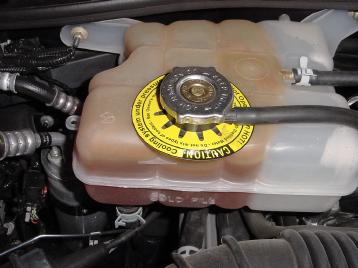Coolant recovery system plays an important role in vehicle cooling system. The separate recovery tank of the system serves as both a coolant reservoir and expansion/recovery tank in low-profile crossflow radiators since they don’t have top tanks like older top fill radiators.
As engine coolant heats up, it expands. In older top fill radiators, an inch or two of dead air space in the top of the radiator provided the necessary room for expansion. If the coolant got too hot, it would force its way past the spring-loaded radiator cap to relieve pressure, and any coolant that escaped would flow through a discharge tube into a recovery tank.
With modern coolant recovery systems, the radiator cap is no longer on top of the radiator, and the radiator has no upper tank to allow for expansion. So the radiator is connected to an external reservoir that serves as both an expansion tank and coolant recovery tank.
Troubleshooting
Coolant recovery systems require no maintenance except for checking the coolant level periodically (say once a month or when you change oil).
If the coolant level is low, it may indicate a leak.
* Visually inspect the radiator, hoses, water pump and coolant recovery system for any signs of coolant leakage.
* Check the operation of the cooling fan. An often undiagnosed cause of overheating is an electric cooling fan that fails to come on due to a faulty temperature sensor, relay, motor or wiring problem. If the engine has a mechanical fan with a clutch, check the clutch for signs of fluid leakage or excess slippage. The silicone fluid inside a fan clutch loses viscosity over time which increases the slippage in the clutch and reduces cooling.
* Remove the filler cap or radiator cap and inspect the gasket inside. If the gasket is cracked, deformed, damaged or missing, the cap is leaking and must be replaced.
* Look up the pressure rating for the filler cap or radiator cap for your vehicle (which can be found in a radiator cap parts catalog). Compare the rating with the pressure rating marked on the old cap. If someone replaced the cap with the wrong one, it may not be sealing properly and is leaking pressure (and coolant).
* A repair shop, radiator shop or car dealer can use a special pressure tester to test the cap and cooling system to check for leaks. A leak-free system should hold pressure for several minutes. If the pressure drops during the test, it indicates a leak somewhere. The worst case would be an internal coolant leak caused by a bad had gasket or a cracked cylinder head or engine block.
* Inspect the coolant reservoir cap and opening for nicks, damage or cracks that might allow coolant to escape from the system.
* Inspect the recovery tank for cracks, split seams or leaks. If damaged, the tank must be replaced. Replacement tanks can be purchased at most auto parts stores or car dealers. Don’t waste your money on a used coolant recovery tank from a salvage yard because plastic can become brittle with age and the used tank may be no better than the one you are replacing.
* If the recovery tank contains sediment, the tank must be cleaned or replaced. Sediment may clog or jam the pressure relief/siphon valve in the radiator cap, and can contribute to accelerated wear in the water pump if it is siphoned back into the cooling system.
* If the recovery tank is dry (and the radiator is full), the recovery tank may be leaking, or the hose or tube that connects the tank to the radiator may be loose, pinched, plugged or leaking.
Coolant Precautions
If the coolant level is low and coolant needs to be added to the recovery tank, add premixed antifreeze or a 50/50 mixture of full strength antifreeze and distilled water (never ordinary tap water that contains minerals and salts).
Also, use the SAME type of coolant that is already in the system, or a “universal” coolant that is fully compatible with the coolant in the system.
Changing Coolant
Changing the coolant on some late model vehicles can be a challenge because air may become trapped inside the engine, heater or hoses. To vent the trapped air, one or more “air bleed valves” may be located at various points in the cooling system. Opening the valve(s) when the system is being refilled allows air to escape so coolant can completely fill all the voids.
If the trapped air is not removed, it may block the flow of coolant through the heater core resulting in no heat output from the heater. Trapped air may also cause the engine to overheat when the vehicle is driven.
If there are no air-bleed valves, you may have to temporarily loosen a heater hose to vent air. Another trick is to use a jack to raise the front of the vehicle so the radiator is higher than the heater core. This should allow most of the air to escape as coolant is added.

The hidden truth of car cooling system
by
Tags:
